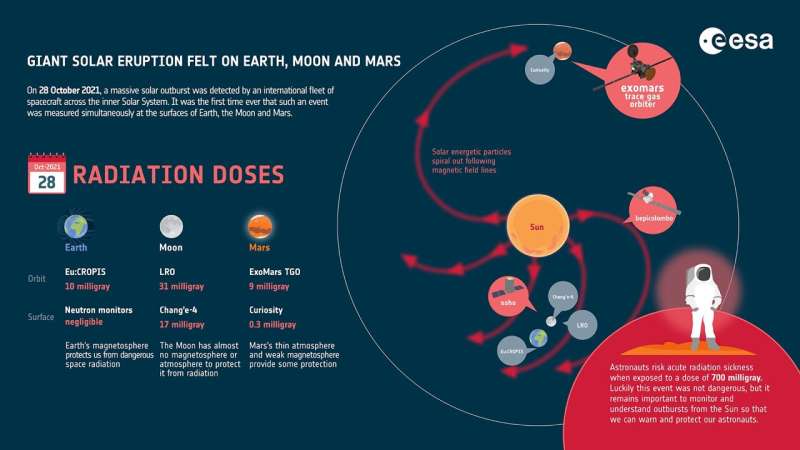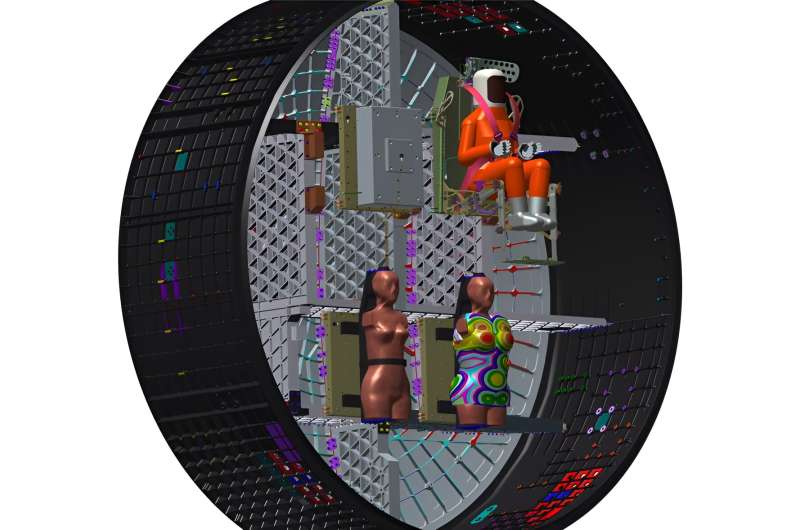
A coronal mass ejection erupted from the sun on 28 October 2021 and was spread over such a wide area that Mars and Earth, while on opposite sides of the sun and around 250 million kilometers apart, received an influx of energetic particles.
This marks the first time that a solar event was measured simultaneously on the surfaces of Earth, the moon and Mars. The outburst was detected by an international fleet of spacecraft including ESA’s ExoMars Trace Gas Orbiter (TGO), NASA’s Curiosity Mars rover, the CNSA Chang’e-4 moon lander, NASA’s Lunar Reconnaissance Orbiter (LRO), and DLR’s Eu:CROPIS Earth orbiter. “The first ground level enhancement seen on three planetary surfaces: Earth, moon, and Mars,” is published in Geophysical Research Letters.
These simultaneous measurements on different worlds help improve our knowledge of the impact of solar outbursts and how a planet’s magnetic field and atmosphere can help protect astronauts against them.
Comparing different worlds
The event that took place on 28 October 2021 is an example of a rare “ground level enhancement.” During these events, particles from the sun are energetic enough to pass through the magnetic bubble that surrounds Earth and protects us from less energetic solar outbursts. This was only the 73rd ground level enhancement since records began in the 1940s, and none have been recorded since.
As the moon and Mars do not generate their own magnetic fields, particles from the sun can easily reach their surfaces, and even interact with the soil to generate secondary radiation. But Mars does have a thin atmosphere that stops most of the lower energy solar particles and slows down the highly energetic ones.
With the moon and Mars as the focus of future human exploration, it is extremely important to understand these solar events and their potential impact on the human body. Astronauts face the risk of radiation sickness. A radiation dose above 700 milligray—the unit for the absorption of radiation—may induce radiation sickness via destruction of the bone marrow, resulting in symptoms such as infection and internal bleeding.
If an astronaut receives more than 10 gray, they are extremely unlikely to survive more than two weeks. One solar outburst in August 1972 would have given such a high radiation dose to an astronaut on the lunar surface, but it fortunately fell between the crewed Apollo 16 and 17 missions.
By comparison, during the event on 28 October 2021 the dose in lunar orbit, measured by NASA’s Lunar Reconnaissance Orbiter, was only 31 milligray. “Our calculations of the past ground level enhancement events show that on average one event every 5.5 years may have exceeded the safe dose level on the moon if no radiation protection had been provided. Understanding these events is crucial for future crewed missions to the surface of the moon,” says scientist Jingnan Guo who researched the 28 October event.
When we compare the measurements made by ExoMars TGO and by the Curiosity rover, the protection offered by Mars’s atmosphere becomes clear: TGO measured 9 milligray, 30 times more than the 0.3 milligray detected on the surface.
ESA’s inner solar system missions Solar Orbiter, SOHO and BepiColombo were also caught in the blast of the outburst, providing even more vantage points to study this solar event.
“Currently, we live in a golden age of solar system physics. Radiation detectors aboard planetary missions such as BepiColombo, on its way to Mercury, and Juice, cruising to Jupiter, add a much-needed coverage to study the acceleration and propagation of solar energetic particles,” remarks Marco Pinto, ESA research fellow working on radiation detectors.
Protecting our astronauts
Protecting astronauts as they venture into space is an essential and important task for ESA. Understanding and predicting intense radiation events is a vital part of this. Dedicated instruments measure the radiation environment in space and are used to protect critical spaceborne and ground-based infrastructure but also astronauts. If warned on time, astronauts could seek protection such as bodywear or shelter in caves. Current policy on the International Space Station is to retreat to the sleeping quarters or the kitchen, where walls shield against radiation.

Lunar Gateway
The Artemis program that is sending astronauts to the moon includes a space station in lunar orbit, called the Gateway. On the Gateway three suites of instruments will monitor the radiation environment around the moon: ESA’s European Radiation Sensors Array (ERSA), NASA’s Heliophysics Environmental and Radiation Measurement Experiment Suite (HERMES) and the ESA/JAXA Internal Dosimeter Array (IDA).
Together these experiments will measure the radiation environment outside Gateway while monitoring the specific radiation doses inside, between 3,000 km and 70,000 km from the lunar surface. These measurements will be critical for better understanding the environment astronauts will experience in interplanetary space.
Luna twins
Space agencies are also looking into protective attire to minimize the impact of space radiation on the body. Two identical mannequins, developed by the German Aerospace Center (DLR), were passengers on the Artemis I test flight, which flew by the moon during November and December 2022.
The mannequins, nicknamed Helga and Zohar, were modeled based on the female body and were equipped with radiation sensors provided by DLR and NASA. Helga flew unprotected, but Zohar wore a newly developed radiation protection vest covering her torso. Researchers at DLR are currently comparing the two datasets measured by Helga and Zohar.
Colin Wilson, ExoMars TGO project scientist, concludes: “Space radiation can create a real danger to our exploration throughout the solar system. Measurements of high-level radiation events by robotic missions is critical to prepare for long-duration crewed missions. Thanks to data from missions like ExoMars TGO we can prepare for how best to protect our human explorers.”
More information:
Jingnan Guo et al, The First Ground Level Enhancement Seen on Three Planetary Surfaces: Earth, Moon, and Mars, Geophysical Research Letters (2023). DOI: 10.1029/2023GL103069
Provided by
European Space Agency
Citation:
Giant solar eruption felt on Earth, moon and Mars (2023, August 3)
retrieved 5 August 2023
from https://phys.org/news/2023-08-giant-solar-eruption-felt-earth.html
This document is subject to copyright. Apart from any fair dealing for the purpose of private study or research, no
part may be reproduced without the written permission. The content is provided for information purposes only.
